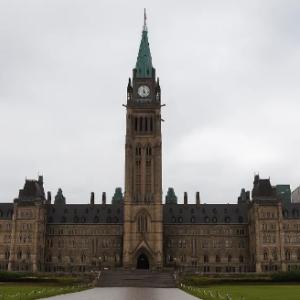An Abridged History of Toronto’s Hospitals: community, political, and elite interests
The governance of Ontario hospitals is flawed, but not unalterable. In fact, parts of the current governance model are relatively new and unique to our province, and challenges present themselves cyclically, generation after generation.
A good look at the past 150 years of hospitals in Toronto displays over a century of community organizing, municipal and provincial political tensions – and some familiar family trees. It also helps us envision what future change could look like.
Women's College Hospital circa 1907
Turn of the Century: The Foundations of Toronto’s Hospital System
The bedrock of our current hospital system really started at the turn of the century. A time when Toronto’s hospitals were majority privately-owned and operated by private trusts or Catholic health care networks. Toronto General Hospital was founded by the Loyal and Patriotic Society of Upper Canada in 1819, while the Sisters of St Joseph founded St Michael’s Hospital in 1892 and St Joseph’s Health Centre in 1821.
This era also marks the beginning of the Eaton family getting involved with stewardship of our hospitals with Timothy Eaton pledging to help build a new hospital in 1905. His third son, Sir John Craig Eaton would carry on the family’s business and hospital legacies with large donations to Toronto General. In later generations Frederick S Eaton would become a major player in the 1990s amalgamation of multiple hospitals to form UHN, where George R Eaton has been a board member since 2011. Nicole Eaton, widow of Thor Edgar Eaton and former Conservative Senator, sits on the board of St Michael’s Foundation. The relationship between the Eatons and our hospitals is inextricable from their wealth.
Who builds hospitals, and whom they are built for, has evolved significantly. Before hospitals were publicly funded and run, access to care and practice was limited to those who could afford it, had the right connections, or practiced a certain faith. Community driven movements and funding expanded the scope of both practice and care. A major example is Women’s College Hospital fighting for women’s health and medical education. It was the first hospital where women were recognized as practicing medical professionals, opening with seven beds in 1907. Another example is the hospital which would become Mt Sinai, which began when four Jewish immigrant women Mrs. Cohn, Miller, Spiegel and Adler, raised funds for a hospital where Jewish doctors could practice and serve the growing Jewish-Canadian diaspora.
Post-War Era: The Shift to Publicly Funded Healthcare
After two world wars, the great depression, and a baby boom, the role of hospitals matured. The move towards publicly owned, operated, and government funded health care was slower in Ontario than in other provinces. Saskatchewan led the way in 1947 by initiating a universal public hospital insurance plan. British Columbia followed suit in 1949, and when Newfoundland joined Canada that same year they brought along their own hospital insurance plan. In 1958 Manitoba, Newfoundland, Alberta, British Columbia and Saskatchewan started to integrate federal cost sharing. Ontario jumped on the bandwagon in 1959.
The cost sharing infrastructure of hospitals had moved to a more standardized and equitable approach than at the turn of the century, but there were still gaps and challenges. With changing governments with varying budget priorities, hospitals developing various speciality centers, and unique local issues, there remained a need for additional funding, a challenge which persists today.
Hospital Foundations: Bridging the Funding Gap
“As the need for funds increases, the resulting pressure on a hospital board to focus its attention on fundraising may detract from the board's primary focus which is the overall supervision of the management of the hospital and the delivery of health services. [...] Further, the establishment of a foundation signals to the community a high degree of commitment by the hospital to fundraising and a desire for public support and voluntary giving towards the purchase of new equipment, special services, updated facilities and innovative programs, above and beyond the day-to-day hospital operations”. – The Effects of Health Care Restructuring on Hospital Foundations in Ontario
Foundations relieve hospital board members from fundraising duties so that they can focus on day-to-day operations. Usually with one or more board members having dual roles on the hospital and foundation board to ensure strategic alignment. The foundation boards set strategic plans and fundraising priorities, including research and innovation, specialized clinics, and new hospital equipment.
Despite these mechanisms, inequities in research and care were prevalent and persist into the present. A semi-recent bill introduced by MPP Jill Andrew aims to standardize care for patients with sickle cell disease, who often experience racial profiling that can lead to life altering complications.
They may be imperfect, but at the end of the day, hospital foundations fill gaps created in part by the very structure of our health care system funding model.
Preventative Health Care: A New Focus in the 1970s
By the ’70s a novel understanding of government's role in healthcare had taken hold. A role which emphasized illness and disease prevention as an integral part of creating positive population health outcomes as well as a fulsome understanding of what non-biological factors impact our health, such as environment, lifestyle, and wealth.
“The idea of health promotion grew out of the 1974 Lalonde report, which recognized that determinants of health went beyond traditional public health and medical care, and argued for the importance of socioeconomic factors.”
– Sholom Glouberman, PhD and John Millar, MD, BSc, MHSc, FRCP(c)
Out of the Lalonde report, Canada and most provinces moved towards regional models of health care to deliver a more integrated type of care – except for Ontario. A large part of the appeal for governments to shift into health promotion was economic.. Healthier communities result in less hospital stays, healthcare staffing needs, surgeries, and the associated costs.
Ontario remains unique in its resistance to regional care models of other provinces. Instead of a regional delivery system as recommended from the Lalonde report, Ontario has flirted with District Advisory councils, Local Health Integration Networks, and other mechanisms for regionalizing care.
Late ‘80s and Early ‘90s: Citizen Participation and the HIV/AIDS Crisis
The ‘80s and ‘90s brought significant changes to healthcare on a national and local levels. The passing of the Canada Health Act in 1984 massively impacted hospital governance and funding, and Toronto was experiencing a bit of a cultural moment with respect to citizen participation in decisionmaking.
For example, in 1982, Doctors Hospital became "a multicultural community health campus" (Moser, 1990, pp. 37-38). Its Community Advisory Committee (patients and representatives of various local ethnic groups) helped plan, administer and evaluate health services. Citizens and clients collaborated with managers and doctors to develop a new mission and strategic plan, and participated in a Mental Health Task Force that reviewed programs and recommended and implemented improvements."
– Survival Strategies: the life, death and renaissance of a Canadian teaching hospital
A turning point came when extreme inequity, health bias, community mobilization, and lagging government response all collided during the HIV/AIDS crisis of the ‘80s and ‘90s. The AIDS crisis put health and hospital policy front and centre on the world stage, and the impact of community activists in fighting for just health care cannot be understated. In Toronto, the Wellesley hospital’s governance changes during these years provides a glaring example of how hospital governance and community collaboration directly impact our health during a health crisis.
Wellesley opened as a private hospital in 1911, in its post-war era the hospital board struggled to keep the hospital financially viable and eventually succumbed to its debt and became a public institution in 1942. By the time the 1990s arrived Wellesley Hospital was facing more financial and strategic challenges.
Simultaneously, Toronto’s activists were rallying and organizing around HIV/AIDS. AIDS Action NOW! (AAN!) was formed in response to government inaction, among sit-ins and protests they also developed the Treatment Information Exchange (TIE) which would become an invaluable resource in Canada, eventually renamed to Community Action Treatment Information Exchange (CATIE) which still exists today.
Groups like AAN were instrumental in pushing hospitals like Wellesley towards treatment and research that would improve quality of life for those living with HIV/AIDS. A Community Advisory Panel (CAP) was formed, chaired by Tony Di Pede:
“In '93, '94, a lot of people were dying. A lot of people were dying... So, that creates a type of pain. A type of rage. A type of anger. A type of grief... It's like being in a war zone where all around you your friends and colleagues are falling down dead. So, that made us angry, and I believe it created a type of urgency in our actions. So, we were probably more aggressive and more volatile than might normally be the case in the regular world. When the hospital didn't act, you know, we always thought it would be the end of the world. Because we had no time to waste.”
The CAP obtained funding for outpatient clinics, became involved in the hiring and firing of staff to address patient complaints, and educated staff around the stigma of the disease. The HIV/AIDS CAP was described as “militant”, but its success led to Community Advisory Panels being formed in other areas of healthcare for the hospital as well. Tony Di Pede, CAP Chair, was asked to join the Wellesley Hospital Board formally; “I was very young at that time,” shared Di Pede “and I’m the product of working-class parents. The Wellesley board had bank presidents, people from important Canadian families, heads of some of the major law firms. The chair of the board was the head of Manulife. It’s not my league. But the Wellesley made room for me.”
With community involvement and new board members, the hospital’s adoption of a community focused strategic plan in 1991 not only improved patient outcomes but “the financial picture improved, and the hospital moved from debt to surplus status”. – Survival Strategies, pg 2
On the provincial side, Ontario was beginning to embrace determinants of care from a legislative perspective notably through Michael Decter, Minister of Health under Bob Rae, who most notably in his book Healing Medicare: Managing Health System Change the Canadian Way “offers clear-headed options for socially-conscious health care reform”. In his book he poses the question "Does your hospital really need to exist at all?". Arguing that there are multiple community interventions and programs that impact our overall health. Unfortunately this sort of ideologizing ultimately served as a convenient rhetorical entry point that was utilized by austerity politicians justifying calls to close hospitals for being too costly, without the accompanying investment in community care that Dechter was actually advocating for.
Wellesley Hospital would face the consequences of hospital cuts by the incoming Harris government, but not without a fight.
Harris Era: Austerity and its Impact on Healthcare
Many of us associate the Mike Harris government with health cuts, which we will dive into shortly, but it's vital that we speak about the Harris era to include the context of what allowed these cuts to happen and the template created and path forged for future austerity governments. Harris’s treatment of our healthcare system was damaging, but it was not unique.
The types of cuts Harris executed had been attempted before, and halted by Superior Court rulings and public opinion.
“In 1975, the Progressive Conservative government of Bill Davis had decided that hospital services should be rationed. It had decided which hospitals should be closed; the Toronto targets included several of the institutions that served ethnocultural communities and were seen as having relatively weak political support.” – Survival Strategies, page 23
The decision faced major public outrage—including a snowball incident aimed at Health Minister of the time Frank Millerand the government retreated its position after the "Provincial Supreme Court unanimously held that the Hospitals Act did not grant statutory power to exercise financial control over hospitals”. The Harris government passed an omnibus bill, the Savings and Restructuring Act (Bill 26), that would act as a loophole around the Supreme Court ruling that stopped his predecessors.
While Harris was going after healthcare, his “Common Sense Revolution” also hit municipal governments, hard. While Toronto was managing local health cuts it was also undergoing amalgamation spurred by the Harris government which led to significant constraints.
Later, during the Rob Ford mayorship and economic struggles of Toronto, John Lorinc reflected “The most punishing blow—the big bang, from a municipal revenue perspective—came in 1997, when the Harris government, having rammed amalgamation through, decided to relieve municipalities of the burden of funding education in exchange for “downloading” the costs of transit, public housing, and parts of welfare”.
That his brother, Doug Ford, would go on to become Premier of Ontario and immediately come for Toronto’s municipal governmentwith his cut to city council in 2018, followed up with dissolving Local Health Integration Networks in 2019, downloading public health care costs to municipalities, and beginning to make moves towards the privatization of health care in 2019 becomes less surprising within this historical context.
Another move from the austerity politics playbook is the selective adoption of recommendations.
When Harris assembled the Health Services Restructuring Commission (HSRC) he tasked them with the reduction of beds, amalgamation of hospitals, and lowering healthcare costs. However, he did not apply their recommendations consistently. The largest omission being the reinvestment into community services to offset health care costs and closure impacts. Decades later, communities not only suffered the closure of hospitals and a slow (or nonexistent) pace of reinvestment into community services, but hospitals have now become more expensive to operate.
“[An] outstanding issue in most communities is the perceived slow pace of reinvestment in the community sector, in expanding the capacity of mental health care, supportive housing and other community-based services, and especially home care. From the hospital and community perspectives alike, the funding available is insufficient to support changing caseloads, including those associated with population growth.[...] Generally speaking, reinvestment, including that recommended by the HSRC, has not significantly altered the balance between hospital and community-based service expenditures. In fact, the budgets of most community-based services have been flatlined for several years, while hospital budgets have increased.”
– Riding the Third Rail
There are many parallels between Mike Harris’s flawed implementation of the HSRC recommendations, and Doug Ford’s pandemic response. While Ford assembled a scientific advisory table to implement health precautions and manage the spread of COVID-19, the advisors were frequently ignored and frustrated.
“Our provincial government did everything other than implement restrictions and offer support that would help curb the spread. So they essentially did nothing useful. They rejected all of our recommendations, like implementing support for essential workers.”
– Dr. Andrew Morris
“We can't ignore the situation we are in, which is dire already. We can't afford this anymore.” – Dr. Peter Jüni
While Progressive Conservatives use the same playbook, that doesn’t absolve other governments from their mishandling of healthcare, which has also left long term damage.
Board Restructuring: Shifting Dynamics in Health Governance
As covered in my previous article on skills gaps in hospital boards, boards are liable for their own self governance and encouraged to ‘nominate’ only the same number of new board members as there are open positions.
This is the norm now, but it wasn’t until Dalton McGuinty’s Liberals stepped in on hospital board governance that this practice became common. In response to proposed legislative changes a 2012 media release from Ontario Healthcare Coalition describes our current reality:
“Kevin Smith and the McGuinty government are continuing their trend of trying to wipe out democratically elected hospital boards and replace them with appointed boards. Under the guise of “skills-based boards” – a red-herring – they are setting up a system in which CEOs can easily dominate the boards and have less accountability to communities.”
Ontario has a long history of community elected hospital boards, and as we saw in the 90s during the HIV/AIDS crisis, community members have the power to drastically improve health care outcomes.
In 2004 McGuinty’s Liberals passed The Future of Medicare Act (Bill 8), which among other things tightened the power dynamic between the provincial government and local hospitals. At the time hospitals warned it would give too much power for the government to control hospital boards, and unions warned that it opened the door towards privatization.
A few short years later and this reality began to play out as the government intervened in hospital board elections with concerns that hospital boards were ‘at the mercy’ of community members
In 2007 Deputy Premier George Smitherman appointed a supervisor to Scarborough Hospital in response to the community ‘threatening to overthrow the hospital’:
“At a meeting last fall when the board was to elect four new members, it instead presented four candidates, sparking accusations it had handpicked new colleagues. Ms. Chu began a petition to have all 10 elected members removed, but the board said the petition was void because the "annual" memberships of most of those who had signed it had expired in September. Ms. Chu became a member in June, 2006.”
The tense situation between new financial pressures that hospitals faced after Bill 8, the closing of departments and services communities relied on, and community backlash played out in other hospitals across the province including Stevenson Memorial in Alliston where the entire board quit overnight.
Concurrently, another controversial bill, the Local Health System Integration Act (Bill 36), which would establish Local Health Integration Networks (LHINs), was pushed through by the Liberal government. The LHINs in theory could have moved Ontario in the direction of a regionalized health model that other provinces operate under, but the rushed legislation and lack of community input raised several issues and concerns. “This is a major piece of legislation with significant implications for the health care system. This legislation grants major new powers to Cabinet, the minister, and his appointees in the LHINs to order restructuring, amalgamations, closures and contracting out in the health system. The LHINs will be responsible for $20 billion worth of health care funding,” said Bea Levis, Seniors organizations’ representative to the Ontario Health Coalition board.
It is in this environment that the Ontario Auditor General published a report specifically on the governance of hospital boards. Throughout the report community members are characterized as risks rather than assets, and board members are cast as apolitical experts.
A few excerpts:
“More than 55% of hospitals have bylaws permitting individuals to pay a small fee or meet other criteria to become community “shareholder” members, which entitles them to elect the board members of the hospital. There is a risk that a hospital’s priorities can be significantly influenced if enough board members are elected who have a specific agenda or represent a specific interest group.”
“In certain circumstances, however, community “shareholder” members may impede the board’s decision-making ability.”
“The OHA’s report, Hospital Governance and Accountability in Ontario, noted the importance of aligning community “shareholder” membership with the effective functioning of the hospital board to “preclude the potential for inappropriate members or, worse, a hijacking” of the board’s agenda.”
“A 2007 hospital peer review commissioned by the Ministry indicated that, at one hospital, it was “evident that board members are subjected to influence by selected members of the community including those that are politically active. The board must ensure that processes are in place to balance localized advocacy groups and are not aligned with only one of the many community-based coalitions.”
Board members are not immune from political alignments as reading these reports may suggest. In our review of Toronto’s hospital and hospital foundation boards it was revealed that a large portion of board members are affiliated with the Progressive Conservative Party of Ontario. It is also apparent that significant potential exists for the emergence of perverse incentives with respect to board members and their business goals. The McGuinty government’s impact in creating barriers between communities and the hospitals that serve them may have achieved the government’s short term goals, but governments change.
Healthcare in the Ford Era: Privatization, Financial Strains, and the Diminishing Community Voice
Upon assuming office in 2018, Doug Ford's government began to enact legislation that facilitated a move towards greater privatization of health services, leading to reduced spending in community healthcare, and accelerating the download of financial burden onto municipalities. The Ford government also fostered close ties between itself and hospital boards, while simultaneously diminishing the influence of local communities in healthcare decisions. These changes have had lasting impacts, setting the stage for many of the practical and pressing challenges faced by public healthcare today.
Hospitals across the province currently grapple with unprecedented financial strain, a consequence of policies favouring private healthcare facilities and reduced government funding. This fiscal pressure has led to an alarming majority of hospitals projecting deficits, resorting to high-interest loans, and facing a very uncertain future. The system seemingly teeters on the edge of sustainability. The government’s approach to managing hospital funding and staffing has not only strained resources but has also prompted concerns about the long-term implications for patient care and community health. In this era of controversy and transformation, the echoes of policies-past continue to resonate, reminding us of the cyclical nature of healthcare governance and the enduring need for an equitable approach.









